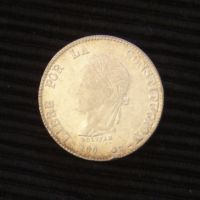Although Bolivia is not considered a wealthy country, they have some of the most beautiful and interesting coinage of Latin America. Bolivian coins are sought after by collectors of Latin America due to the varied portraits of Simon Bolivar: liberator of the northern part of the continent from Spain.

Liberators Latin America's Struggle for Independence 1810-1830 Robert Harvey, 2000.
This is an excellent reference on the Liberation of Latin America during this period.
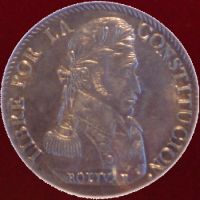
8 soles, 1827
Military Bust (1827 - 40) KM# 97
very select uncirculated NGC-63
(Alex Siegel Houston, 2006)
This is a lifetime issue of Simon Bolivar and his 1st portrait coin. As such a lot of care was taken on the design and strike, contrary to latter issues made after his death.
The Whittier collection contained no Bolivian 8 soles issued before his death in 1830. However it did have a mint state 1827 2 soles which also had a lot of obverse detail.
Simon Bolivar, featured on this coin, had suceeded in defeating the Spanish Colonial Forces but was trying to keep newly independent Gran Colombia from breaking up.

8 soles, 1831
Military Bust
select uncirculated
(Alex Siegel Houston,
1997)

8 soles, 1838
All of these coins were struck at the www.boliviafacts.net/potosi.html Potosi mint, Bolivia (actual link no longer works). The mint mark is "PTS" all superscribed, and the mountain of silver which Potosi once was, is featured on many of the coins. I guess, with todays silver prices, you can no longer go there and dig silver out of the ground with your bare hands?
This is the typical posthumous issue with low relief. In the early 2000's, fully lusterous uncs with no hairlines could be easily bought for $100 - $135. I was afraid I was buying too many at those prices and they would turn out like the ms Mercury dimes: I bought as a kid: very common and a bad investment.
Moneda Feble (weak coins)
By secret decree of Marshal Andrés de Santa Cruz, stong man of Bolivia,
minor denomination coins were to be struck in low grade (.6666 fine) silver. This did not affect the larger 8 Soles which were made for export
to Europe but all coins from 4 Soles and less were made with the debased silver starting in 1830.
Additionally the design and the
date of the coins was to be frozen with the year "1830". Production of these debased silver coins continued until a new design
appeared in Potasi in 1853.
According to H.P.Flatt, "while the merchants of Bolivia & Peru quickly learned of the decreased value of the coins, the public continued to be deceived for years..." In fact the specimen illustrated here appears to be bright high purity silver and just as good as any sterling silver coin in visual appearance. These monedas febles drove good local currency out of circulation, damaged the economy for years and led to a war between Bolivia & Peru.
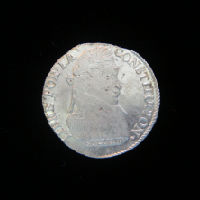
Monedas Feble 4 soles, 1830 Potasi
standard Military Bust
frosty uncirculated
(Karl Stephens, $79)
For more discussion on Monedas Feble see the Ecuador page. Most of the small change circulating in Ecuador at this time was Bolivian Monedas Feble.
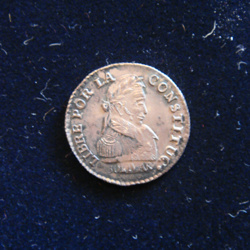 half sole, 1830
half sole, 1830
First or "Military" Bust (1827 - 40)
uncirculated
(Jim Elmen World Wide Coin Auction, 2010)
This is another Military or 1st style Bust of Bolivar and is .666 fine; it has a darkish tone. This is another example of moneda feble.
There was also an unc 1827 one sole in the same auction but it went for a very high price to which I couldn't go.

8 Escudos, 1837
First or "Military" Bust (1827 - 40)
uncirculated (NGC-62)
(Heritage Auctions, Boston ANA, Aug 16th,
2010, lot# 20261)
The early Bolivar portrait was the military Bust was used from 1827 until 1840. However I believe the first gold pieces are from ~1831
In this instance he followed the example of George Washington, who was the top military commander during the US Revolution, and who retired to private life after serving 2 terms as President.
This is why Simon Bolivar commands such respect in Latin America today.

8 soles, 1846
First Civilian Bust (1841 - 48)
KM# A103, uncirculated
(Alex Siegel Houston,
1997)
This coin was out of some famous numistmatist's collection,
I have to try & find out who it was.
While hardly a specialist on these types this one looks more like KM# 103 than KM# A103
to me. Type # A103 has the obverse of # 97 (see above). Please advise anyone???

8 soles, 1851 Civilian Bust KM# 109
choice uncirculated
Ex: Paul Karon's Collection
Ex: Alex Siegel Collection
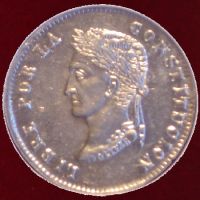
8 soles, 1852
Civilian Bust "Bolivar on base" KM# 112.1
select uncirculated NGC-62
bought from Paul Brombal c. 2001
from Alex Siegel Houston, 2006
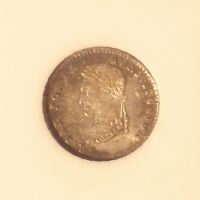
1 reale, 1856/5
Bust of Simon Bolivar w/ name on base
Arno Safran (private acquisition)
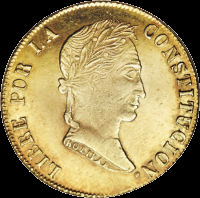
8 Escudos, 1856 FJ
Bust of Simon Bolivar w/ name on base
choice unc
It appears that the Peso denomination came into being in Bolivia around 1859, replacing the 8 soles. However due to the mass of counterfeit & debased coinage circulating in the country, nobody cared what they called it. Foreign buyers only cared about the weight & fineness of silver which is why that & no denomination is indicated on the coin.
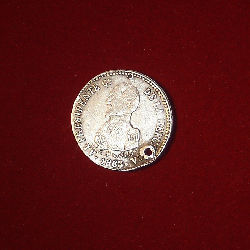
2 Soles General Jose Maria Acha 1863
gift from Carlos Jara, 2008
These coins were termed "Monedas Especiales" or "Special Money" by George Lille 3rd. The coin has a straight reeded edge and all of these types were issued for circulation and in fact were highly circulated and invariably holed. They are quite different from the "Proclamation Pieces" of the Spanish Kings which were usually dated at the King's ascention, did not circulate, and are sometimes labeled "Proclamation".
This may be why the term was incorrectly extended to these coins but they are quite different.
If you want to see the pictures accompanying the Caudillo article, email me.
The coin clearly is dated "1863" my poor photographic skills made this appear to be 1907.

Melgarejo, 1 Melgarejo 1865
select uncirculated, NGC-63,
with planchlet flaw on back of head
Goldbergs Millenium Auction, 2008
Don Canaparo, 12/2000
Alongside of the 1 Mel, 1/2, 1/4, and 10 Melgarejo denominations were issed, apparently for regular circulation. These are available in unc but I've not yet been able to get one. I am very interested in purchasing both the 1/2 Melgarejo and the 10 Melgarejos: both of which are available in high grade. The 1 Melgarejos were issued in 1865 and 1866.
Melgarejo was one of the most notorius dictators of Latin America and ruled from 1865 to 1871. For other Latin American dictators, shown on comtempoary coins click here.
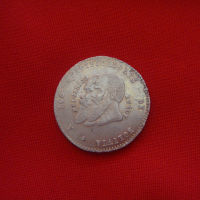
Melgarejo & Munoz,  half Melgarejo
1865, almost uncirculated (AU)
private acquisition, Mar, 2009
Actually in response to my comments about needing a half Mel, a collector contacted me & sold me this piece. Now all I need is to be so lucky with the 10 Mel coin!

Melgarejo, "Half Reale"
1865, uncirculated (NGC-64)
Carlos Jara, Sept, 2009
This coin is labeled by NGC as a half Reale. Actually I'm unsure whether it's a half Sole or a 1/20th Peso or a 1/20th Melagarejo? Since Republican Bolivia never used the Reale denomination, I'm not sure how NGC got a half Real designation, particularly as late as 1865. However, it's best not to argue with the experts.
